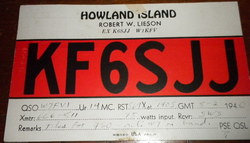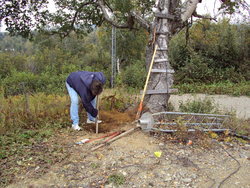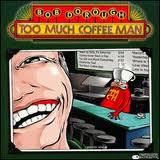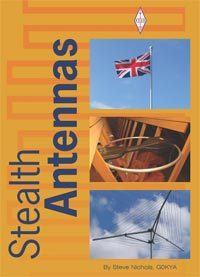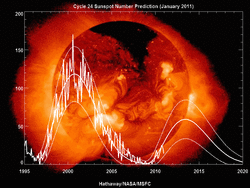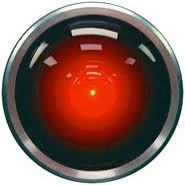 January 19, 2011 Editor: Ward Silver, NØAX | |||||||
IN THIS ISSUE
NEW HF OPERATORS - THINGS TO DO FYBO - that stands for "Freeze Your Butt Off" and it's the winter Field Day-style event sponsored the QRP AZSQRPions in a couple of weeks on Feb 5th. Not every HF event is totally serious, you know! Since one of the scoring inputs is the temperature of your operating location, the zeroes have home-field advantage! BULLETINS WPX SSB log checking reports are available. If you submitted a log, you should have received an email from WPX Contest Director K5ZD (k5zd@charter.net). BUSTED QSOS The K9VV mentioned in the previous issue's story about SDR web sites was actually N9VV. (Thanks, Dan K1TO and Art K6XT) CONTEST SUMMARY Complete information for all contests follows the Conversation section January 22-23
January 29-30
The big story of the past two weeks is welcome news for VHF+ contesters as the ARRL's online Logbook of the World (LOTW) now supports VUCC awards. The ARRL Web article reviews the changes and answers some of the immediate questions about getting started. LOTW will also support the Fred Fish Memorial Award - earned by only two grid-chasing stations so far! The ARRL Outgoing QSL Service, for those who prefer paper to programs, announced new rates effective this week.
While the ARRL LOTW site does have a lot of supporting instructions, Dave, AA6YW, author of DXLab Suite, has created his own complementary set of instructions for adding locations to your TQSL software configuration - a key element of successful LOTW use. (Thanks, Peter N5UWY) The North Coast Contesters have announced the 19th Annual Dayton Contest Dinner and are taking ticket orders. This is the venue for CQ Contest Hall of Fame inductions and the keynote speaker is always enjoyable. The dinner will be held on Friday, May 21st, at the Crowne Plaza Hotel. (Thanks, Tim K3LR) In discussing participation in the ARRL 10 Meter Contest by Mexican stations, Ramon XE1KK and Hector XE2K contributed additional information about Mexican licensing. Perhaps the clearest explanation of the complicated process is available from Christian DL6KAC - it applies for both resident and visiting hams. How does this stack up to other ITU Region 2 licensing? The comparison shows that it's tough to be an XE licenseholder with the highest fees of any Region 2 country! Mexican ham radio licensing rules have been translated into English by George XE1/N9VIU. Note that no Mexican national may allow any other person to use his or her call sign. Both Ramon and Hector remind us that, like in many other countries, abuse of the rules by visitors helps keep restrictive regulations in place. Does it seem hot in here? Only about a million, more or less. Is that F or C? Scientists are making good use of the new solar observatory satellites to learn just how the corona gets so hot! Since the corona is the source of many solar phenomena that affect radio propagation, understanding its mechanics has a lot of practical use right here on terra firma. The group managing the ARRL Frequency Measuring Tests (FMT) has announced a new format for the April 12th (April 13th UTC) exercise. More information will be printed in the March issue of QST or you can keep an eye on FMT manager Connie K5CM's web site for more information.
The Minnesota QSO Party (Feb 5) is working hard to be sure all 87 counties are activated - even roving in frigid temperatures that would freeze a sine wave! The MN QSO Party County Activity Map is color-coded to show expected county activations and clicking on a county shows call signs "signed up" to activate it. The web site will also track the rovers in real-time via APRS as the contest progresses. Pretty cool! (Thanks, Bob KØRC) Alberto LU1DZ writes in with notification of a new web site for the CW World Wide South America Contest. Results of previous contests will be published here when they are available. W3KM has updated his Cabrillo Log Evaluator software - it's very useful for contest sponsors that use the Cabrillo log format for submissions. If your club sponsors a contest, why not encourage the use of the standard format and make your log-checking life a bit easier? Individual contesters may find the Cabrillo Log Checker to be helpful in converting and managing their logs. (Thanks, John WA2HIP and Bob N6TV) Web Site of the Week - Science fairs are a lot of fun for the technically-inclined student and encourages them on their way to a career in engineering or science. Google has launched its own Global Science Fair project for entrants between the ages of 13 and 18. Each project is created as a Google web site and the judges will be actual scientists and technical professionals. Maybe that new antenna or digital protocol would catch their eye? WORD TO THE WISE Endurance - this is a plus for both contesters, DXpeditioners, and sailors. With some of our contesting compadres headed for the South Orkneys this week, Endurance by Caroline Alexander about the explorer Shackleford's adventures in the same area might be a good read while waiting for them to reach the island. Says, Rus K2UA, "So many lessons for all of us about teamwork, faith, and the human spirit in the face of incredible adversity [that] the Southern Ocean dishes out even in the summer." If it seems like the QRN from a thunderstorm is curiously strong, perhaps it's just the echoes of matter-antimatter annihilation! It turns out that thunderstorms can actually create antimatter and gamma rays like a giant particle accelerator. The NASA story has lots of interesting graphics and animations to explain how this happens. You'll never look at big cumulonimbii the same way! What is it like to land on a remote Pacific atoll? Take a look at this cockpit video of a Gulfstream twin-engine coming in over the lagoons and reefs. (Thanks, Katie Stadler) The Hallicrafters SCR-299/HT-4 transmitter did yeoman's service in World War II and was a legendary surplus item in the post-war years. Here's a long video looking back at a ham radio icon. (Thanks, John W7KCN) A very nice analysis of the 2010 UBA contests with notes about logs and log checking has been posted by our Belgian correspondent, Franki ON5ZO. The results of the 2010 Ohio State Parks on the Air Contest are online. (Thanks, Joe W8KNO) SYLRA Contest 2010 Final Results are ready online - congratulations to all the trophy winners! (Thanks, Janne OH6LBW/OH6M) LZ DX Contest 2010 preliminary results are now on-line and become official on 15 Feb. (Thanks, Wally LZ2CJ) OPERATING TIP
How to Build A Pot, by Festus - "Most people just don't know how to make good coffee. In the first place, they boil the water before they put the coffee in. Any fool knows you gotta put the coffee in the cold water and bring them both to a boil together. That way you get all of the flavor. Worst thing they do, they throw away the old grounds after using them once. What they don't know is that they are throwing away the best part. You got to keep them old grounds and you add a little fresh coffee every morning and let her boil. Shoot, you don't make a cup, you build a pot. You don't really get a good pot until you've been usin' it about a week. Then it's coffee!" - Festus was a memorable character played by Ken Curtis on the Gunsmoke TV show. Amplifier fuses may not be the usual glass-cartridge style. If yours uses ceramic cartridge fuses, you can often find them as "microwave oven fuses". They are also available from electronic suppliers, such as Mouser Electronics. Don't substitute glass fuses as they are not rated to handle or interrupt the same current and voltage. (Thanks, Jim W7RY and Vic K2VCO)
Looking up the connections of a microphone can be maddening - there are so many, the manufacturers all use different conventions, signal names are different. Ugh. To the rescue rides Roy, G4WPW with his amazing compilation of microphone connector wiring and schematics. Three cheers for the compilers of information among us! Speaking of (or into) microphones, if you are the type that enjoys putting the end of a vacuum cleaner hose next to the cat and making growly noises into the other end, you might enjoy learning that a toilet paper tube placed over certain microphones can have interesting effects on the resulting transmitted audio. This was a regular "enhancement" for the Kenwood MC-60 desk mike, for example. Will it improve your score? The reply is somewhat hazy! If you have a Pelican hard-shell equipment case, but need foam inserts for cushioning equipment, Dan KI4YZE recommends Foamerica.com as having a complete selection. Here's a way to evenly space any number of radials around an antenna base. First, find the circumference of the circle that contains the shortest radial: C = 2*pi*r, where r is the length of the shortest radial. Divide C by the number of radials. This is the distance between the radials as they cross the circle. Using this method, even an irregular area can be covered with evenly-spaced radials. (Thanks, Rod WN8R) At the other end, to what do you connect the radials? There are all sorts of suggestions from pre-drilled and threaded radial connection plates to scavenging bent aluminum wheel rims from an auto body shop. Dave AB7E reminds us that while it looks pretty, the electrons don't care if the radial attachment is made in a circle - you can use short lengths of bus bar or flashing strip around the antenna to make several radial connections as a strip or with the ends connected together forming a polygon. Reminder - call before you dig! No matter where you live in the U.S. there is a phone number you can call to check for buried cables and pipes before the first shovel of dirt is turned. Call your local utility to find out who does the job in your area.
Technical Web Site of the Week - Are you suffering through the oh-so-slow beginnings of solar cycle 24? Paul VE1DX offers some Cassidic-inspired wisdom featuring the Palos Verdes Sundancers. If you want something to occupy you until the cycle has progressed a little farther, read this interesting paper about orbital resonances of the outer planets and their effects on the Sun. (Thanks, Rich KL7RA) Whither, Single-Op? In the last issue, I discussed how radio is changing from a one-at-a-time to everybody-at-once. ("Parallel to Serial", 5 Jan 2011) That makes a big difference in how we think of what we do and how we compete. Another big game-changer is the ability of software to compete with the "wet-ware" between our ears. Just this past week, in a practice round Watson, the IBM-designed supercomputer, beat the all-time Jeopardy champs at their own game. Does the relentless advance of computers put our own game in jeopardy? No more than the advent of steam-power eliminated sailing competitions. Nor has technology relegated sailing to the back-benches of re-enactment hobbies. Read through the reporting on the America's Cup sailing yacht races and you will find competition as intense as any cutting-edge sport. Yet, it is important to clearly identify what technological apples are being compared. Indeed, a race of the sailing against engine-powered vessels would not be much of a draw. We need to make the same set of distinctions in radiosport. As always, definitions are important. First, let's start with the word "assisted" as it is found in category definitions. Although contest rules for "Single-Op Assisted" categories are clear, there is lots of confusion. The only thing to which the term "assisted" applies is to receiving information about other contest operation from outside your station boundary and via something else than the contest bands and modes. It does not apply to devices or persons that help you make a bigger score. This was once clear and understood by pretty much everybody, but there is that word with all its superfluous connotations. It really needs to be changed. The discussion about "assisted" categories and "assistance" actually covers two completely distinct things; the first is the use of information I just described, usually from what is referred to as a "spotting network." (This is still called "packet", although the use of actual packet radio links to carry the information is rapidly disappearing in favor of Internet links.) The information itself consists of any data about the operation of another contest station, such as frequency, time, exchange, or call sign. The second thing is the use of non-human devices in support of one's operating. Mixing these two different topics in one category definition is guaranteed to make for a difficult conversation. (The additional consideration of single- versus multi-operator, I'll leave for another column.) Confusion about the first topic can be defused by using a more appropriate title for the category. For example, "Single-Operator with Spotting Network" (SO-SN). Say what you mean and mean what you say. If an operator uses information from the spotting network, that is an SO-SN entry. If we want to be completely general and refer to the information alone - a better definition - then a more appropriate name for the category might be "Single-Operator - Connected" although the inevitable "connected to what?" arises. Nevertheless, in this category the operator is allowed to use information about the operation of other stations received from sources outside the station boundary.
Defining "assistance" from non-human devices is not quite as straightforward. After all, electronic keyers were a huge leap forward when they were introduced. A clever layout of paper dupe sheets was certainly helpful - isn't the ARRL's version, after all, called "Operating Aid Number Six"? (What happened to aids one through five and was there a seventh?) And what about computer logging? Having been immersed in this argument for some time, it is apparent to me that the crux of the argument is technology that replaces a crucial human function - that of turning an audio stream into the information required to make a record of a contest contact. i.e. automated decoding or "copy". (Realize that the rest of this discussion must necessarily exclude radiosport using digital modes since humans are not capable of copying digital transmissions. Yes, we all have heard the story about the RTTY operator who could recognize call signs...) At present, with the exception of CW Skimmer and the occasional code reader, there is no device in the amateur shack that turns Morse code's on-off patterns of audio tones into characters. Similarly, there is no device (outside of certain large government agencies) that reliably translates the audio of human speech into characters. Thus, we have a key, well-defined "bottleneck" through which all operation can be constrained to pass in order to qualify for a specific category. If "copy" is defined as translating audio into alphanumeric characters, then "manual copy" is a human performing the copying function. An appropriate category name for such operation might be "Single-Operator, Manual Copy" (SO-MC) and one for which copying devices are allowed, "Single-Operator, Automated Copy" (SO-AC) So now we have three potential categories; SO-MC, SO-AC, and SO-SN. Do we really need all three? Not really, in my opinion. The trend in contest operating is clearly to add more technology and more information. In the face of such upheaval, it's important to provide an entry category for "sail-powered radio" and the savvy salts that steer them. Almost equally important, the category names should not make value judgments about the style of operating - we're all very good at doing that ourselves, thanks. I propose the following two names for our categories: Single-Operator, Manual Class (SO-MC) and Single-Operator, Cyber Class (SO-CC). SO-MC consists of a single human operator, receiving no information from outside a physical station boundary except on the bands and modes permitted for contest contacts and using no devices that translate the information carried by transmitted signals into the characters required to conduct and make a record of the contact. Band scopes and spectrum analyzers are fine. Code readers, CW Skimmers and other automated decoders in any mode that extracts and evaluates a signal's information, speech-to-text translators, and so forth are excluded. SO-CC consists of a single human operator but no limits are placed on the information that can be used or its sources. I'm sure contest sponsors would need to refine those definitions but they are a start. The wind-sailor and motor-boater have managed to get along for nearly 200 years, sharing waterways and devising rules of navigation that allow all to share the rights of way. Competitions are enjoyed by all for what they are. Surely we can do the same. 19 January to 1 February An expanded, downloadable version of QST's Contest Corral in PDF format is available. Check the sponsor's Web site for information on operating time restrictions and other instructions. HF CONTESTS NAQCC Monthly QRP Sprint--CW, from Jan 20, 0130Z to Jan 20, 0330Z. Bands (MHz): 3.5-14. Frequencies: Monthly on 2nd Tuesday or 3rd Wednesday (alternating). Exchange: RST, S/P/C, and NAQCC mbr nr or power. Logs due: 4 days. Rules Locust QSO Party--CW, from Jan 20, 0200Z to Jan 20, 0300Z. Bands (MHz): 3.5-7. Frequencies: 3.553, 7.053. Exchange: Name, state or province or 'DX'. Logs due: Jan 31. Rules YLISSB QSO Party--Phone, from Jan 22, 0000Z to Jan 23, 2359Z. Bands (MHz): 1.8-28. Exchange: Call sign, RS(T), ISSB number. Logs due: Mar 18. Rules BARTG RTTY Sprint--Digital, from Jan 22, 1200Z to Jan 23, 1200Z. Bands (MHz): 3.5-28. Exchange: Serial. Logs due: Mar 1. Rules CQ WW 160 Meter Contest--CW, from Jan 28, 2200Z to Jan 30, 2200Z. Bands (MHz): 1.8. Exchange: RST and S/P/C. Logs due: Feb 28. Rules REF French Contest--CW, from Jan 29, 0600Z to Jan 30, 1800Z. Bands (MHz): 3.5-28. Exchange: RST and serial or department ID. Logs due: 30 days. Rules UBA Contest--Phone, from Jan 29, 1300Z to Jan 30, 1300Z. Bands (MHz): 3.5-28. Exchange: RS, serial, and ON province. Logs due: 2 weeks. Rules Winter Field Day--Phone,CW,Digital, from Jan 29, 1700Z to Jan 30, 1700Z. Bands (MHz): 1.8-28, 50+. Exchange: Call sign, RS(T), category, local temp. Logs due: Feb 28. Rules WAB Top Band Phone Contest--Phone, from Jan 29, 1900Z to Jan 29, 2300Z. Bands (MHz): 1.8. Exchange: See Web site. Logs due: 21 days. Rules Classic Exchange--CW, from Jan 31, 1400Z to Feb 1, 0800Z. Bands (MHz): 1.8-28, 50, 144, Frequencies: CW 1.810, 3.545, 7.045, 14.045, 21.135, 28.050, 50.100, 144.100 . Exchange: RST, QTH, model of rcvr and xmtr. Logs due: 30 days. Rules VHF+ CONTESTS ARRL January VHF Sweepstakes--Phone,CW, from Jan 22, 1900Z to Jan 24, 0400Z. Bands (MHz): 50+. Exchange: Grid square. Logs due: Feb 24. Rules Winter Field Day--Phone,CW,Digital, from Jan 29, 1700Z to Jan 30, 1700Z. Bands (MHz): 1.8-28, 50+. Exchange: Call sign, RS(T), category, local temp. Logs due: Feb 28. Rules LOG DUE DATES 19 January to 1 February January 19 - ARCI Holiday Spirits Homebrew Sprint January 19 - RSGB 80m Club Championship, SSB January 22 - AGB New Year Snowball Contest January 22 - North American QSO Party, CW January 23 - Run for the Bacon QRP Contest January 24 - DARC 10-Meter Contest January 25 - RAEM Contest January 25 - LZ Open Contest January 29 - North American QSO Party, SSB January 31 - Stew Perry Topband Challenge January 31 - Lighthouse Christmas Lights QSO Party January 31 - Original QRP Contest January 31 - RAC Winter Contest January 31 - AGCW Happy New Year Contest January 31 - NRAU-Baltic Contest, CW and SSB January 31 - SARTG New Year RTTY Contest February 1 - International Naval Contest February 1 - Feld Hell Sprint February 1 - Kid's Day Contest ARRL Information Click here to advertise in this newsletter. Your One-Stop Resource for Amateur Radio News and Information ARRL membership includes QST, Amateur Radio's most popular and informative journal, delivered to your mailbox each month. Subscribe to NCJ - the National Contest Journal. Published bimonthly, features articles by top contesters, letters, hints, statistics, scores, NA Sprint and QSO Parties. Subscribe to QEX - A Forum for Communications Experimenters. Published bimonthly, features technical articles, construction projects, columns and other items of interest to radio amateurs and communications professionals. Free of charge to ARRL members: Subscribe to The ARRL Letter (weekly digest of news and information), the ARES E-Letter (monthly public service and emergency communications news), Division and Section news -- and much more! ARRL offers a wide array of products to enhance your enjoyment of Amateur Radio. Visit the site often for new publications, specials and sales. Donate to the fund of your choice -- support programs not funded by member dues! ACKNOWLEDGEMENTS ARRL Contest Update wishes to acknowledge information from WA7BNM's Contest Calendar and SM3CER's Contest Calendar. | |||||||
